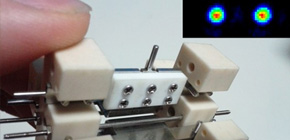
Successful observation of two-phonon quantum interference
A major contribution to quantum information processing
A research group at Osaka University has succeeded in observing at the intended timing two-phonon quantum interference by using two cold calcium ions in ion traps, which spatially confine charged particles.
A phonon is a unit of vibrational energy that arises from oscillating particles within crystals. Two-particle quantum interference experiments using two photons or atoms have been previously reported, but this group's achievement is the world's first observation using two phonons.
This group demonstrated that the phonon, a quantum mechanical description of an elementary vibrational motion in matter, and the photon, an elementary particle of light, share common properties. This group's research results will contribute to quantum information processing research, including quantum simulation using phonons and quantum interface research.
Ion traps are an important technique in physically achieving quantum information processing including quantum computation, and research on ion traps is being carried out all over the world, with Dr. David J. Wineland of the United States, a leading expert in the field, winning the Nobel Prize in Physics in 2012.
For this research, a team from Osaka University led by Shinji Urabe, Professor Emeritus, Kenji Toyoda, Assistant Professor, and Atsushi Noguchi (currently at the Research Center for Advanced Science and Technology, The University of Tokyo) used a laser to irradiate 2 calcium ions to completely remove almost any movement energy from the ions. After this, the team caused a single phonon to form at each of the ion sites.
Since there is mutual interaction between the two ions, this causes the phonons to move and mutually interfere with each other. In the case of classical particles, there is a possibility that the particles will be detected individually at each of the sites. However, with phonons, since the effects of two-phonon interference eliminate the possibility of each particle being detected individually, it was predicted that the two phonons would be detected simultaneously at one of the two ion sites.
Through experimentation, the two phonons were in fact detected at the same site, confirming that the probability of simultaneous detection of the phonons at individual ion sites is close to zero. This phenomenon is a distinctive interference effect in bosonic particles such as photons, elementary particles of light, and phonons, the quantum of vibrational energy; a typical phenomenon which indicates quantum characteristics.
Since this phenomenon can only be observed when the quantum particles have been properly prepared simultaneously, the success rate when performed with photons is limited. However, with ion traps, individual phonons can be created with a high level of control, allowing for successful observation at specific timing on demand.
This research was featured in the UK's Nature on Thursday, Nov. 5, 2015.

Ion trap and two ions
To learn more about this research, please view the full research report entitled " Hong–Ou–Mandel interference of two phonons in trapped ions " at this page of the Nature website.
Related links
